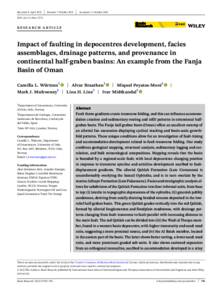Document
Impact of faulting in depocentres development, facies assemblages, drainage patterns, and provenance in continental half-graben basins: An example from the Fanja Basin of Oman.
Identifier
DOI: 10.1111/bre.12731
Contributors
Braathen, Alvar., Author
Poyatos-Moré, Miquel., Author
Mulrooney, Mark J., Author
Line, Lina H., Author
Midtkandal, Ivar., Author
Publisher
Basin Research.
Gregorian
2022-10
Language
English
Subject
English abstract
Fault throw gradients create transverse folding, and this can influence accommo dation creation and sedimentary routing and infill patterns in extensional half graben basin. The Fanja half-graben basin (Oman) offers an excellent outcrop of
an alluvial fan succession displaying cyclical stacking and basin-scale growth fold patterns. These unique conditions allow for an investigation of fault-timing
and accommodation development related to fault-transverse folding. Our study
combines geological mapping, structural analysis, sedimentary logging and cor relation, and bulk mineralogical compositions. Mapping reveals that the basin
is bounded by a regional-scale fault, with local depocentres changing position
in response to transverse syncline and anticline development ascribed to fault displacement gradients. The alluvial Qahlah Formation (Late Cretaceous) is
unconformably overlying the Semail Ophiolite, and is in turn overlain by the
marine Jafnayn Formation (Late Palaeocene). Facies and stratigraphic analysis al lows for subdivision of the Qahlah Formation into four informal units, from base
to top: (i) laterite in topographic depressions of the ophiolite, (ii) greenish pebbly
sandstones, deriving from axially draining braided streams deposited in the low relief half-graben basin. This green Qahlah grades vertically into the red Qahlah,
formed by alluvial fanglomerates and floodplain mudstones, with drainage pat terns changing from fault-transverse to fault-parallel with increasing distance to
the main fault. The red Qahlah can be divided into (iii) the Wadi al Theepa mem ber, found in a western basin depocentre, with higher immaturity and sand: mud
ratio, suggesting a more proximal source, and (iv) the Al Batah member, located
in the eastern part of the basin. The latter shows better sorting, a lower sand: mud
ratio, and more prominent graded sub-units. It also shows eastward expansion
from an orthogonal monocline, ascribed to accommodation developed in a relay
ramp. Changes in sedimentary facies and depositional patterns are consistent
with differential mineralogical composition. The Green Qahlah is composed of
quartz and lithic mafic rock fragments, sourced from the ophiolite and schists of
the metamorphic basement. The Red Qahlah is composed of chert and kaolinite
sourced from the Hawasina Nappe succession in the footwall of the master fault.
These changes in source area are linked to unroofing of fault-footwalls and domal
structures during the extensional collapse of the Semail Ophiolite. The novelty of
this study resides in linking sedimentology and fault-displacement events con trolling fault-perpendicular folding, and its influence on depocentre generation
and stratigraphic architecture. This is an approach seldom considered in seismic
analysis, and rarely analysed in outcrop studies, thus placing the results from this
study among the key outcrop-based contributions to the field.
Member of
Resource URL
Category
Journal articles

